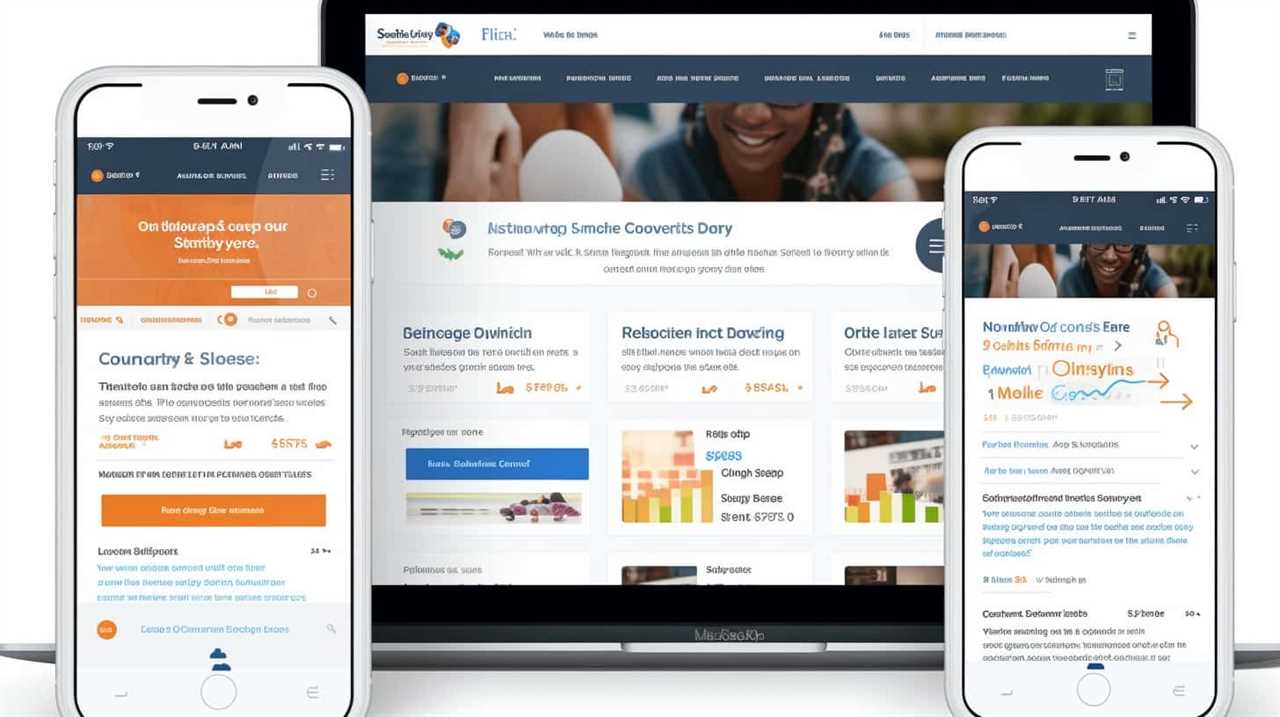Ever wondered what enchantments occur behind the scenes to optimize a website for search engines? We’re thrilled to draw the curtain aside and unveil the mysteries!
In this article, we’ll delve into the world of onsite SEO and explore the various components it encompasses. From meta tags to content optimization, keyword research to site speed, we’ll cover it all.
So, grab your metaphorical magnifying glass and let’s uncover the secrets of effective onsite SEO together!
Key Takeaways
- Meta tags optimization plays a crucial role in enhancing website visibility and driving organic traffic.
- Keyword research and optimization are essential for improving website visibility on search engines and ensuring relevant and valuable content for users.
- URL structure optimization with clean and keyword-rich URLs improves search engine visibility, user experience, and click-through rates.
- Site performance and user experience optimization, including site speed, mobile-friendliness, conversion rate optimization, and website navigation improvement, are vital for enhancing website performance and encouraging desired user actions.
Meta Tags Optimization
In our discussion of onsite SEO, we’ll delve into the importance of optimizing meta tags.

Meta tags are snippets of text that provide information about a webpage.
When it comes to meta tags best practices, there are a few key elements to consider.
First and foremost, the meta description is crucial. It’s a concise summary of the webpage’s content and plays a significant role in attracting users to click on your website in search engine results. By crafting a compelling meta description that includes relevant keywords, you can increase the chances of users visiting your site.
Additionally, it’s important to optimize other meta tags like the title tag and meta keywords tag, ensuring they accurately reflect the content of the webpage.

Mastering the art of meta tags optimization can greatly enhance your website’s visibility and drive organic traffic.
Keyword Research and Optimization
When it comes to onsite SEO, keyword research and optimization play a crucial role in improving a website’s visibility on search engines.
One important aspect is finding the optimal keyword density to ensure that the content is relevant and valuable to users.
Additionally, conducting competitor analysis for keywords allows us to identify opportunities and refine our strategy for better search engine rankings.

Optimal Keyword Density
Our research and optimization of keywords focuses on achieving the optimal density for improved onsite SEO. Keyword density analysis is an essential part of our strategy, as it allows us to determine the ideal number of times a keyword should appear on a webpage.
By optimizing keyword usage, we ensure that the content remains relevant and valuable to both users and search engines. However, it’s crucial to strike a balance and avoid excessive keyword stuffing, as this can harm the website’s rankings.
Our goal is to provide high-quality content that incorporates keywords naturally and seamlessly. Through careful keyword research and optimization, we can enhance the visibility and organic traffic of a website, ultimately leading to better SEO performance.
Competitor Analysis for Keywords
To optimize keyword usage and enhance onsite SEO, we conduct competitor analysis for keywords through research and optimization. This involves analyzing the keywords that our competitors are targeting and determining their level of competition. Here are five competitor analysis techniques that we use for keyword research and optimization:

- Identifying competitors: We identify our main competitors in the industry and analyze their keyword strategies.
- Keyword research: We use various tools to conduct keyword research and identify relevant keywords for our website.
- Analyzing keyword competition: We assess the competition level for each keyword to determine the difficulty of ranking.
- Targeting low-competition keywords: We prioritize targeting keywords with lower competition to increase our chances of ranking higher.
- Monitoring competitor keyword rankings: We continuously monitor our competitors’ keyword rankings to stay updated and adjust our strategy accordingly.
Content Optimization
Content optimization is a crucial aspect of onsite SEO that focuses on enhancing the quality and relevancy of the content on our website. It involves implementing a well-defined content strategy and following SEO best practices to improve the visibility and performance of our website in search engine rankings.
To optimize our content, we need to conduct thorough keyword research to identify relevant keywords and phrases that our target audience is searching for. We should strategically incorporate these keywords into our content, ensuring a natural and organic flow.
Additionally, we must pay attention to the structure and formatting of our content, using headings, subheadings, and bullet points to make it more readable and scannable.
URL Structure Optimization
When it comes to URL structure optimization, there are a few key points to consider.

First and foremost, clean URLs are essential for SEO. They should be descriptive, relevant to the content, and free of unnecessary characters or symbols.
Additionally, keyword placement in the URL can help improve search engine visibility and rankings.
Importance of Clean URLs
In our article on onsite SEO, we’ll explore the significance of clean URLs in optimizing URL structure.
Having a clean URL structure offers several benefits, including:

- Improved user experience: Clean URLs are easier for users to read and understand, making it more likely for them to click on the link.
- Better search engine visibility: Search engines prefer clean URLs as they provide clear information about the content of the page.
- Increased click-through rates: Clean URLs tend to have higher click-through rates as they appear more trustworthy and relevant to users.
- Easier sharing and linking: Clean URLs are more shareable and easier to link to, both internally and externally.
- Enhanced website organization: A well-structured URL hierarchy helps search engines understand the overall structure of your website.
Keyword Placement in URLs
To continue optimizing URL structure, we’ll now delve into the importance of keyword placement in URLs.
Proper keyword placement in URLs is crucial for SEO success. When creating URLs, it’s important to use relevant keywords that accurately describe the content of the page. This won’t only help search engines understand the purpose of the page but also improve the overall user experience. Keyword research techniques can be utilized to identify the most effective keywords to include in URLs.
By strategically placing keywords in URLs, you can increase the visibility and relevance of your webpages in search engine results. Effective keyword usage strategies in URLs can significantly impact your website’s ranking and drive more organic traffic.
Now that we understand the importance of keyword placement, let’s move on to the next section, which focuses on URL length and readability.

URL Length and Readability
Let’s now explore the optimization of URL length and readability for effective onsite SEO. When it comes to URLs, readability is key. By following URL best practices, you can ensure that your URLs are easy to read and understand for both search engines and users. Here are five tips for optimizing your URL structure:
- Keep it concise: Shorter URLs are generally better for SEO.
- Use keywords: Include relevant keywords in your URLs to improve search engine visibility.
- Avoid special characters: Stick to alphanumeric characters and hyphens to keep URLs clean and readable.
- Use lowercase letters: Consistency in letter case helps with URL readability.
- Structure logically: Organize your URLs in a logical manner that reflects your website’s hierarchy.
Now that we’ve optimized our URL structure, let’s move on to discussing the importance of an internal linking strategy.
Internal Linking Strategy
Our internal linking strategy incorporates relevant anchor text to enhance the user experience and improve website navigation. Internal linking strategy is an essential aspect of on-site SEO, as it helps search engines understand the structure and hierarchy of your website.
By strategically linking relevant pages together using optimized anchor text, you can guide users and search engine bots to important content within your site. Anchor text optimization involves using descriptive and keyword-rich phrases that accurately reflect the content of the linked page. This not only helps users navigate your website more efficiently but also signals to search engines the relevance and importance of the linked pages.

An effective internal linking strategy can also help increase the visibility and organic rankings of your website.
Site Speed Optimization
Site speed optimization is an important factor in improving the overall performance and user experience of a website. To ensure that your website loads quickly and efficiently, here are some key aspects to consider:
- Site speed analysis: Conduct a thorough analysis of your website’s current speed performance to identify any bottlenecks or areas for improvement.
- Page load time optimization: Implement techniques such as compressing images, minifying CSS and JavaScript files, and leveraging browser caching to reduce page load times.
- Content delivery network (CDN) integration: Utilize a CDN to distribute your website’s content across multiple servers, reducing the distance between users and your server.
- Mobile optimization: Optimize your website’s speed for mobile devices, as mobile users expect fast loading times.
- Regular monitoring and maintenance: Continuously monitor your website’s speed and make necessary adjustments to ensure optimal performance.
Mobile-Friendliness
Continuing from the previous subtopic, an important aspect of onsite SEO includes ensuring mobile-friendliness.
With the rise of mobile usage, it’s crucial for websites to have a responsive design that adapts to different screen sizes and resolutions. A responsive design ensures that your website looks and functions well on all devices, providing a seamless user experience.

This not only improves user satisfaction but also contributes to better search engine rankings.
Additionally, load time optimization is another key factor in mobile-friendliness. Mobile users expect fast-loading websites, and search engines prioritize sites that offer a speedy experience.
By optimizing your website’s load time, you can enhance both user experience and SEO performance.
User Experience Optimization
To achieve effective onsite SEO, we prioritize optimizing user experience. User experience optimization plays a crucial role in improving website performance and increasing conversion rates. Here are five key areas to focus on:

- Conversion rate optimization: Analyze user behavior and make data-driven changes to improve the conversion rate of your website.
- Website navigation improvement: Ensure that your website is easy to navigate, with clear menus and intuitive user flows.
- Mobile responsiveness: Optimize your website for mobile devices to provide a seamless experience for users on smartphones and tablets.
- Page load speed: Improve loading times to minimize user frustration and increase engagement.
- Clear and compelling calls to action: Use persuasive language and prominent buttons to encourage users to take desired actions.
Frequently Asked Questions
How Does Onsite SEO Differ From Offsite SEO?
Onsite SEO and offsite SEO differ in their focus. Onsite SEO involves optimizing elements on a website to improve its visibility and search engine rankings. Offsite SEO, on the other hand, involves activities outside the website to increase its authority and relevance.
What Are Some Common Mistakes to Avoid When Optimizing Meta Tags?
When optimizing meta tags, it’s important to avoid common mistakes. By focusing on improving meta tag optimization, we can increase website visibility and attract more organic traffic.
How Can I Ensure That My Website’s Content Is Both Optimized for SEO and Engaging for Users?
To optimize content for SEO and engage users, we focus on keywords, meta tags, and high-quality writing. By incorporating relevant keywords and creating engaging content, we increase visibility and attract more visitors.
Are There Any Best Practices for Structuring URLs for Optimal Seo?
When it comes to structuring URLs for optimal SEO, we follow best practices for keyword research and emphasize the importance of internal linking. This helps us ensure our website is well-optimized and user-friendly.

What Are Some Effective Strategies for Improving Site Speed and Mobile-Friendliness?
Improving site speed and mobile optimization are crucial strategies for SEO. Enhancing site speed increases user experience and search engine rankings. Mobile optimization ensures that websites are mobile-friendly and accessible, improving overall SEO performance.
Conclusion
In conclusion, onsite SEO includes various strategies to optimize your website for search engines and improve user experience.
By optimizing meta tags, conducting keyword research, and optimizing content and URLs, you can enhance your website’s visibility and attract more organic traffic.
Additionally, implementing a strong internal linking strategy, optimizing site speed, and ensuring mobile-friendliness will further enhance the overall user experience.

By focusing on these aspects, you can effectively improve your website’s search engine rankings and drive more targeted traffic to your site.










